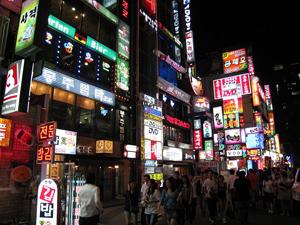Growing Debt Worries for South Korea
The Gangnam District in Seoul at night. (Photo: Yoshi/Wikipedia)
In South Korea, “Gangnam Style” isn’t just a Korean music video that’s gone viral; it’s a way of life.
Gangnam is a district south of the Han River that’s associated with moving up the social ladder. Some families start their ascent by putting their kids into expensive schools there.
Cheon Sun-kyoung, 48, moved with her family to Gangnam so that her teenage daughter could attend one of Seoul’s best private tutoring, or cram schools to prepare for the national university entrance exam.
“To Korean mothers, living here in Gangnam means that you are sending your kids to the best schools and giving them more opportunities in life,” Cheon said. “It’s one of the most important things we can do for our children.”
But it comes at a price. Cheon and her husband had to take out a nearly $100,000 loan to pay the deposit for a new apartment. She does her grocery shopping in other, less pricey neighborhoods. She says the family can no longer save money.
Korea emerged from the financial crisis of 2008 largely unscathed, but now some observers say this Gangnam style is prompting fears of an American-style debt crisis in South Korea.
Baek Seong-jin, a financial advisor who deals with personal bankruptcy, says the situation in Korea is similar to what’s happened in the United States. He says that he has seen two to three times as many people going broke and declaring bankruptcy than he did a year ago.
Baek says inflation, a slumping real estate market, and high interest loans are all taking their toll. He points to figures showing that the average family in Korea spends one and a half times their disposable income. That’s a little more than what Americans were spending just before the start of the subprime mortgage crisis in 2008.
Tom Coyner, president of Soft Landing Consulting in Seoul, says South Koreans are racking up debt in similar ways.
“[They] take out six or more credit cards and once they’re maxed out, realizing they couldn’t pay off the balance, they started taking out loans,” Coyner said. “It’s constantly moving the debt around from credit card to credit card.”
It wasn’t that long ago that Korea was a nation of savers. But stagnant wages, a higher cost of living and a desire to spend in order to achieve a better social position are leaving families in the red.
Jeong Young-sik, an analyst at the Samsung Economic Research Institute in Seoul, says Korea’s overspending is the result of modern myths, for instance, that property value always goes up.
“Another myth is that education will increase their social position,” he said.
Jeong notes that real estate loans and private education are the main expenditures driving Korean households into debt. He says the best prescription now is some austerity to deal with the problem.
“The Korean government doesn’t want to increase government debt sharply,” he said. “The most important thing to solve household debt in South Korea is belt tightening.”
Cheon Sun-kyoung says her family has done some belt tightening since moving to Gangnam, but the sacrifice was worth it. She says her daughter is getting a better education and may be able to enroll in a top university.
Still, she is concerned that Korea’s over spending will get the nation into trouble.
“The Korean economy seems to follow America’s, and when I speak to my friends in the US and they tell me about how bad the situation is there, I get worried that we will face the same problems.”
Cheon says once her daughter gets out of high school, she plans to move the family out of Gangnam.
